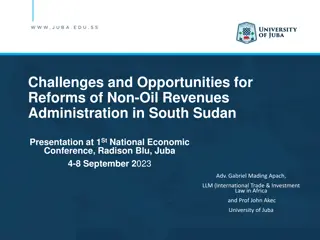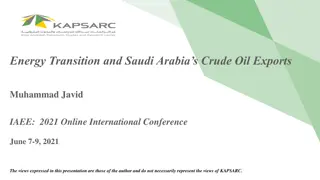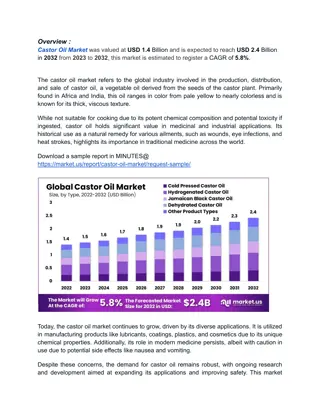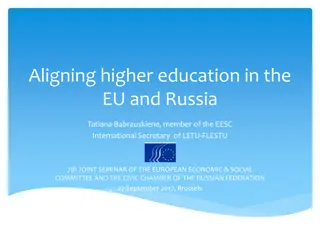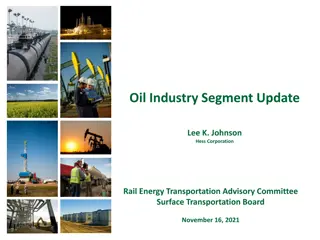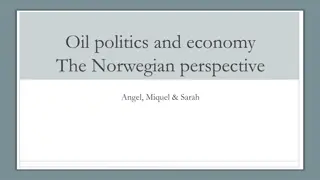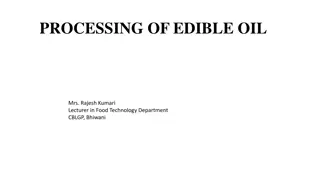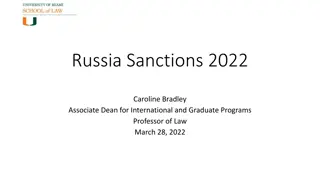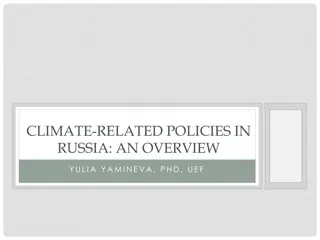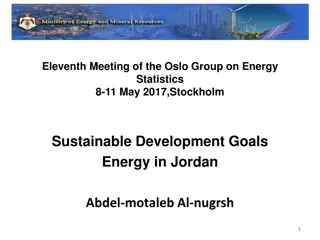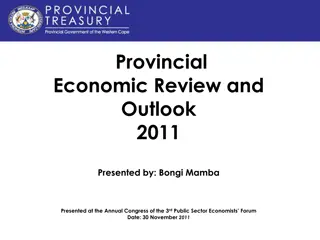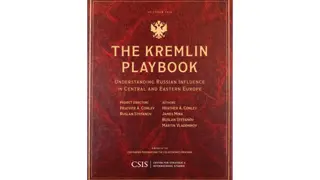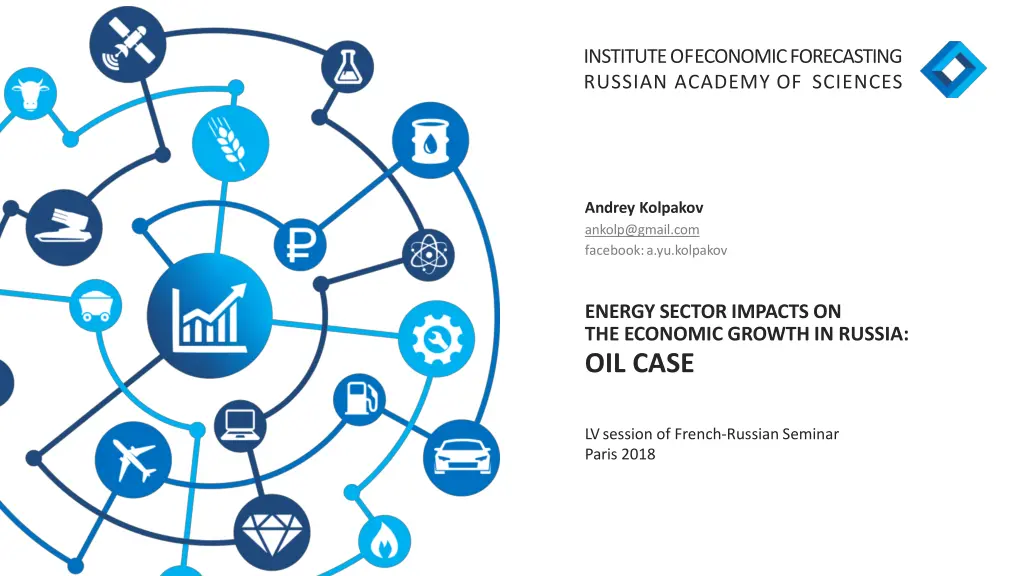
Impacts of Russian Energy Sector on Economic Growth and Budget Revenues
Explore the significant role of the Russian energy sector in economic growth, budget stability, and inter-industry interactions. Learn about the economic potential, rental income generation, and the impact of weakening ruble on oil tax revenues.
Uploaded on | 1 Views
Download Presentation

Please find below an Image/Link to download the presentation.
The content on the website is provided AS IS for your information and personal use only. It may not be sold, licensed, or shared on other websites without obtaining consent from the author. If you encounter any issues during the download, it is possible that the publisher has removed the file from their server.
You are allowed to download the files provided on this website for personal or commercial use, subject to the condition that they are used lawfully. All files are the property of their respective owners.
The content on the website is provided AS IS for your information and personal use only. It may not be sold, licensed, or shared on other websites without obtaining consent from the author.
E N D
Presentation Transcript
INSTITUTE OF ECONOMIC FORECASTING RUSSIAN ACADEMY OF SCIENCES Andrey Kolpakov ankolp@gmail.com facebook:a.yu.kolpakov ENERGY SECTOR IMPACTSON THE ECONOMIC GROWTH IN RUSSIA: OIL CASE LV session of French-Russian Seminar Paris 2018
Energy sector impacts on the economy dynamics in Russia 2 Energy sector share of the main macroeconomic indicators in 2017 GDP 32% Exports 59% Investments 41% Fedralbudget revenues 48% Consolidated budget revenues 31% Employment 7% Direct contribution Interindustry interactions The Russian energy sector remains one of the key factors of economic growth guarantees budget and macroeconomic stability INSTITUTE OF ECONOMICFORECASTING RUSSIAN ACADEMY OF SCIENCES Source: IEF RAS estimations
Economic potential of the Russian energysector 3 Economic potential of the Russian energy sector is rental income generated. It may be used in different ways: 1) taxes to finance the socio-economic politics of the government 2) low domestic prices for energy sources to provide competitive advantages for national producers 3) energy sector income to finance its demand for the national goods and services In Russia, first option is used primarily. Oil case is the most representative: export parity pricing mechanism was applied In the beginning of the 1990s, which caused a significant decrease in the competitiveness of most non-energy sectors ever-increasing fiscal burden forces the oil companies to work hard on their operating efficiency, choosing more competitive imports, which breaks domestic interindustry interactions oil dollars from petroleum exports make it possible to import the necessary goods that the Russian economy is not able to provide INSTITUTE OF ECONOMICFORECASTING RUSSIAN ACADEMY OF SCIENCES
Weakening of the ruble increases the oil tax revenues to the budget 4 Urals price andRub Urals price inRub Rub/bbl 120 5500 5000 100 4500 Urals, USD/bbl 80 4000 60 USD/Rub 3500 40 3000 20 2500 2000 0 2014Jan 2016Jan 2017Jan 2018Jan 2015Jan 2014Jan 2015Jan 2016Jan 2017Jan 2018Jan 2018July 2014July 2016July 2017July 2014July 2015July 2016July 2017July 2018July 2015July USD/Rub rate was traditionally in antiphase to the Urals price. It allowed to smooth out external market fluctuations for the Russian economy. But in the period of summer 2017 march 2018 ruble was stable at rising oil price. And since march 2018 ruble is weakening at rising oil price As a result, the Urals price exceeded 5 thousand rubles per barrel in the august 2018. This is approximately 30% higher the levels of 2011-2014 when oil price was about 100 USD/bbl INSTITUTE OF ECONOMIC FORECASTING RUSSIAN ACADEMY OF SCIENCES Data Source: Ministry of Economic Development of the RussianFederation
Weakening of the ruble increases also domestic gasoline price 5 Factors of gasoline price change in 2018, rubles per liter Responsibility for the gasoline price growth +1.3 -2.2 The only factor that restrained the gasoline price growth was decrease in gas station income +1.7 +3.1 -2.7 43.8 39.8 +5.8 rubles perliter Decrease of theretail Strengthening of the ruble, Gasoline price in2017 Gasoline price in may 2018 Weakening of theruble Taxesincrease World oil priceincrease -2.2 rubles perliter segmentincome which hadn'thappen State responsibility (currency rate,taxes) Oil companies responsibility (gas stationsincome) INSTITUTE OF ECONOMIC FORECASTING RUSSIAN ACADEMY OF SCIENCES Source: IEF RASesVmaVons
Taxmaneuver 6 Tax maneuver impact on the incomes of state budget and oil sector in 2024 (in comparison with the current tax regime) trillion rubles 1,5 Statebudget Oil sector It is said that the main reason for the Tax maneuver is the need to remove export duties as the customs barriers to trade inside the Eurasian Economic Union 1 0,5 Nevertheless, the parameters of the Tax maneuver are adjusted in a way to guarantee additional tax revenues to the state budget 0 -0,5 -1 60 70 80 40 50 90 100 Urals price in 2024,USD/bbl INSTITUTE OF ECONOMIC FORECASTING RUSSIAN ACADEMY OF SCIENCES Source: IEF RAS estimations
Oil produc9on becomes more difficult 7 Changes of the main oil production indicators in 2007-2017 Drilling and wellsefficiency thm thton +11% Oil production 8 4,0 Investments (in constantprices) +44% 7 3,5 Newwells +57% 6 3,0 Drilling +100% 5 2,5 Horizontaldrilling +620% 4 2,0 2007 2008 2009 2010 2011 2012 2013 2014 2015 2016 2017 Additional production by new well, th ton Drilling per well, thm 1. Oil companies need more money to invest 2. If they have money they will invest INSTITUTE OF ECONOMIC FORECASTING RUSSIAN ACADEMY OF SCIENCES Source: IEF RAS estimations
Oil producIon scenarios 8 Oil production and investments scenarios up to 2025 bln rub(2015) mlnton 600 2500 We should focus on the increase in oil production. The challenge is to usepotential of higher investments (in recent years imports-share of investments is 50-60%) 2000 550 1500 500 1000 450 400 500 2010 2011 2012 2013 2014 2015 2016 2017 2018 2019 2020 2021 2022 2023 2024 2025 INSTITUTE OF ECONOMIC FORECASTING RUSSIAN ACADEMY OF SCIENCES Source: IEF RAS estimations
Potential for GDP growth due to the energy sector in Russia 9 Potential additional contribution of energy sector in average annual Russian GDP growth rate in 2019-2025 is 1.33 percentagepoints Potential additional contribution of energy sector in Russian GDP in 2019-2025 0.54 Increase in oil producOon up to 600 mln ton 51 trlnrub AdditionalGDP growth rate dueto economic potential ofRussian energysector Increase in coal production up to 560 mln ton + Railway infrastructure 0.24 1.33 (in prices of2018) 0.2 Increase in natural gas production up to 800 bcm Decrease in the dependence on imports of equipment 0.3 Power sector modernizaOon Infrastructure for oil and gas exports Economicinertia Increase in oil production up to 600 mlnton Increasein coalproductionupto560mlnton+Railwayinfrastructure Increase in natural gasproduction up to 800 bcm Decrease in the dependence onimports of equipment Power sector modernization Infrastructure for oil and gasexports INSTITUTE OF ECONOMIC FORECASTING RUSSIAN ACADEMY OF SCIENCES Source: IEF RASesOmaOons
Taxation of electricity consumption 10 Thank you for your a2en3on Andrey Kolpakov IEF RAS ankolp@gmail.com facebook: a.yu.kolpakov Key points The Russian energy sector remains one of the key factors of economic growth. It guarantees budget and macroeconomic stability There are different ways to use the economic potential of energy sector. Russia focuses on the tax collection to finance the socio-economic politics of the government. Such a strategy restricts economic growth in Russia Increase in oil production seems to be the most adequate scenario for Russia. But there are two challenges: a) profitability of new production projects and b) effective use of higher investments potential Energy sector is able to provide additional 1.33 percentage points of Russian GDP growth rate in a short- and medium-term. It may be a factor of starting and maintaining the economic growth in Russia INSTITUTE OF ECONOMIC FORECASTING RUSSIAN ACADEMY OF SCIENCES


